The upcoming Ethereum bull market will completely ignite the market.
Unveiling the secret waltz of Trump's 'fascist economy' and the crypto bull market — the deadly dance steps of Bitcoin and the 'credit bass drum.' Are you keeping up with your investment dance?
The highest praise of humanity to the universe comes from the joy born of dance. Most religions incorporate some form of music and dance into their worship rituals. And the House Music I believe in, the place where it 'moves your body,' is not the church on Sunday morning but the dance floor at Club Space during the same hours.
In college, I joined the ballroom dance club, using my body to praise the rhythm. Each ballroom dance has strict regulations (for example, in the rumba, you cannot place your center of gravity on a bent leg), and for beginners, the hardest part is to dance the basic steps in time with the beat. The biggest difficulty lies in first determining the beat of a song and then knowing where each beat falls.
My favorite ballroom dance — the cowboy dance — is in 4/4 time; the waltz is in 3/4 time. Once you know the beat, your ears must capture which instrument is accented and count the remaining beats of the measure. If every piece of music is just a bass drum pounding 'one, two, three, four,' it would be very monotonous and boring. What makes music engaging is how composers and producers layer other instruments and sounds to add depth and richness to the song. But when dancing, listening to all these secondary sounds is redundant to place your feet correctly at the right time.
Like music, price charts are fluctuations of human emotions, and our portfolios dance along. Like ballroom dancing, our decisions to buy and sell different types of assets must follow the beat and rhythm of specific markets. If we stray from the rhythm, we will lose money. Losing money, like a dancer out of step, is ugly. So the question arises: if we want to remain beautiful and wealthy, which instrument must our ears listen for in the financial markets?
If my investment philosophy has one self-evident core idea, it is this: the most important variable in profitable trading is understanding how the supply of fiat currency changes.
This is even more critical for cryptocurrencies because, at least for Bitcoin, it is a fixed-supply asset. Therefore, the rate of expansion of the fiat currency supply determines the rate at which Bitcoin's price rises. Since the beginning of 2009, a massive amount of fiat currency has been created, competing for a relatively insignificant supply of Bitcoin, making Bitcoin the best-performing fiat-denominated asset in human history.
Currently, the jarring sounds from financial and political events form a tritone. The market continues to rise, but there are some very serious, seemingly negative catalysts creating dissonance. Should you hedge locally against tariffs and/or war? Or are these just unnecessary instruments? If so, can we hear the guiding force of the bass drum — that is, credit creation?
Tariffs and wars are important because a single instrument or sound can ruin a piece of music. But these two issues are interrelated and ultimately have nothing to do with Bitcoin's sustained rise. President Trump cannot impose meaningful tariffs on China because China will cut off rare earth supplies to the 'pretty country' and its vassal states. Without rare earths, the U.S. cannot manufacture weapons to sell to Ukraine or to Israel. Thus, the U.S. and China are engaged in a crazy tango, each probing to avoid overly destabilizing the entity economically or geopolitically. That’s why the status quo, although tragic and deadly for people in both places, currently has no substantial impact on global financial markets.
Meanwhile, the credit bass drum continues to delineate time and rhythm. America needs industrial policy, which is a euphemism for state capitalism, technically referred to by that dirty word: fascism. The U.S. needs to shift from a semi-capitalist economic system to a fascist economic system, as its industrial giants cannot produce war materials in sufficient quantities to meet the current geopolitical environment based on their own will.
The war between Israel and Iran lasted only twelve days because Israel exhausted its supply of missiles from the U.S. and could not operate its air defense system perfectly. Russian President Putin is unmoved by the U.S. and NATO's deepening support for Ukraine, as they cannot produce weapons at the same quantity, speed, and low price as Russia.
The U.S. also needs a more fascist economic arrangement to boost employment and corporate profits. From a Keynesian perspective, war greatly benefits the economy. The public's lagging organic demand is replaced by the government's insatiable demand for weapons.
Ultimately, the banking system is also willing to provide credit to businesses because they profit guarantees by producing the products required by the government. Wartime presidents are very popular, at least at first, because everyone seems to become wealthier. If we take a more comprehensive approach to measuring economic growth, it becomes very clear that war is highly destructive in net benefits. But that kind of thinking doesn't win elections, and every politician's primary goal is to be re-elected, if not for themselves, then for their party members. Trump is a wartime president, like most of his American predecessors, and therefore, he is placing the U.S. economy in a wartime state. In this way, finding the rhythm becomes easier; we must seek ways in which credit is injected into the economy.
In my article (Black or White), I explained how government-backed profits lead to 'key' industries receiving bank credit. I call this policy 'Quantitative Easing for the Poor (QE 4 Poor People),' which creates a fountain of credit. I predicted this would be the method the Trump team uses to boost the U.S. economy, and the MP Materials deal is our first large-scale real-world case.
The first part of this article will explain how this deal expands the dollar credit supply and will serve as a template for the Trump administration as it attempts to produce key goods (semiconductors, rare earths, industrial metals, etc.) needed for 21st-century warfare.
War also requires the government to continue borrowing huge amounts of money. Even if the assets of the rich swell due to increased credit supply leading to capital gains tax revenue, the government will still face an ever-expanding fiscal deficit. Who will buy this debt? Stablecoin issuers.
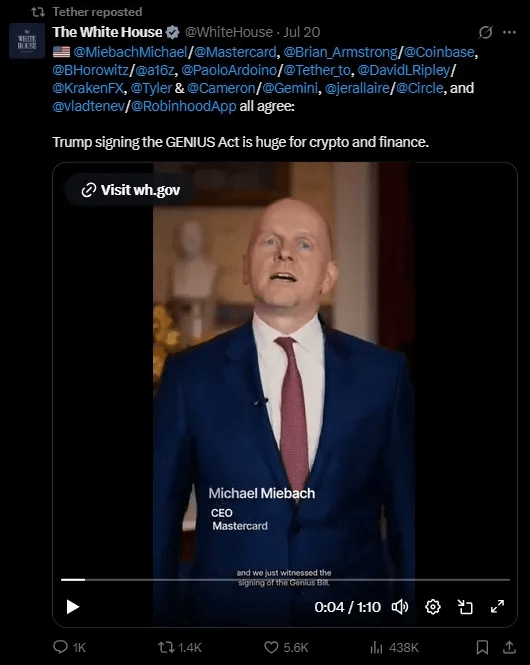
As the total market cap of cryptocurrencies rises, a portion will be stored in stablecoin form. The vast majority of these stablecoins' custodial assets (AUC) are invested in U.S. Treasury bills.
Therefore, if the Trump administration can provide a favorable regulatory environment for traditional finance (TradFi) participation and investment in cryptocurrencies, the total market cap of cryptocurrencies will soar. The custodial assets of stablecoins will automatically increase, thereby creating more purchasing power for Treasury bills. U.S. Treasury Secretary Bessent will continue to issue far more Treasury bills than Treasury notes or bonds for stablecoin issuers to purchase.
Let’s dance a credit waltz, and I will guide readers on how to perfectly execute the S snake step.
Quantitative Easing for the Poor (QE 4 Poor People)
Central bank money printing cannot create a powerful wartime economy. Finance has replaced rocket engineering. To correct this wartime production failure, the banking system is encouraged to provide credit to industries deemed critical by the government, rather than to corporate raiders.
American private enterprises aim for profit maximization. Since the 1970s, engaging in 'knowledge' work domestically while pushing production overseas has yielded higher profits. China is very willing to enhance its manufacturing skills by becoming the world's low-cost, and over time, high-quality manufacturing factory. However, producing a $1 Nike does not threaten the elites of the 'pretty country.' The real issue is that at a time when the 'pretty country' faces a serious threat to its hegemony, it cannot produce war materials. Thus, all the fuss about rare earths arises.
Rare earths are not rare but are very difficult to process, largely due to massive environmental externalities and huge capital expenditure requirements. Over thirty years ago, Chinese leader Deng Xiaoping decided that China would dominate rare earth production, and this foresight can be leveraged by current leaders. Currently, all modern weapon systems require rare earths; thus, it is China, not the U.S., that decides how long a war lasts. To rectify this situation, Trump is borrowing from the Chinese economic system to ensure that U.S. rare earth production increases, allowing him to continue his militaristic behavior.
Here are the key points from Reuters about the MP Materials deal:
The U.S. Department of Defense will become the largest shareholder of MP Materials.
This deal will boost U.S. rare earth production and weaken China's dominance.
The Department of Defense will also provide a floor price for critical rare earth products.
The floor price will be double the current market price in China.
After the announcement, MP Materials' stock price surged nearly 50%.
This is all well and good, but where does the funding for building the factory come from?
MP Materials states that JPMorgan and Goldman Sachs are providing $1 billion in loans to build its 10x capacity factory.
Why are banks suddenly willing to lend to the real industrial sector? Because the U.S. government guarantees that this 'money-losing project' is profitable for borrowers. The T-account below explains how this transaction creates credit out of thin air, leading to economic growth.

MP Materials (MP) needs to build a rare earth processing plant and obtains a $1,000 loan from JPMorgan (JPM). The loan action creates $1,000 of new fiat currency (wampum), which is deposited into JPMorgan.
MP Materials then builds a rare earth processing plant. To do this, it needs to hire workers, namely the 'plebes.' In this simplified example, I assume all costs consist of labor fees. MP Materials must pay the workers, resulting in a debit of $1,000 in the MP account, and the plebes crediting $1,000 in the JPM account.
The Department of Defense (DoD) needs to pay for these rare earths. The funding is provided by the Treasury, which must issue debt to fund the DoD. JPMorgan converts its corporate loan assets to MP into reserves held by the Federal Reserve through the discount window. These reserves are used to purchase debt, leading to an increase in the Treasury General Account (TGA). The DoD then purchases rare earths, which become MP's revenue and ultimately return to JPMorgan in the form of deposits.
The end balance of fiat currency (EB) is $1,000 higher than the initial loan amount from JPMorgan. This expansion is due to the money multiplier effect.
This is how government procurement guarantees finance the construction of new factories and the hiring of workers through commercial bank credit. I didn't include in this example, but JPMorgan will now lend to these 'plebes' to enable them to purchase assets and goods (houses, cars, iPhones, etc.) because they have stable good jobs. This is another example of new credit creation ultimately entering the hands of other American companies, with these revenues being deposited back into the banking system. As you can see, the money multiplier is greater than 1, leading to increased economic activity calculated as 'growth.'
Money supply, economic activity, and government debt are all growing in sync. Everyone is happy. The 'plebes' have jobs, financiers/entrepreneurs have government-backed profits. If these fascist economic policies can magically provide benefits for everyone, why hasn’t this become the global economic policy of every nation-state? Because it would cause inflation.
The human resources and raw materials needed to produce goods are limited. The government is squeezing financing and ultimate production of other goods by encouraging the commercial banking system to create money out of thin air. Ultimately, this will lead to shortages of raw materials and labor. However, fiat currency is not in short supply. Therefore, wage and commodity inflation will follow, which will ultimately cause pain for any individual or entity that has no direct connection with the government or the banking system. If you don't believe me, read the daily history of the two world wars.
The MP Materials deal is the first large-scale, significant case reflecting the policy of 'quantitative easing for the poor.' The best part of this policy is that it does not require congressional approval. The Department of Defense can issue guaranteed procurement orders in the normal course of its business under the instructions of Trump and his successor in 2028. Profit-seeking banks will follow, fulfilling their 'patriotic' duty to provide financing for those companies attached to the government. In fact, elected representatives from all parties will compete to argue why the companies in their constituencies should receive procurement orders from the Department of Defense.
If we know that this form of credit creation will not face political resistance, how can we protect our portfolios from the ensuing inflation?
Blowing bubbles, trying to blow them bigger
Politicians are not unaware that stimulating 'key' industries through accelerated credit growth will cause inflation. The challenge lies in utilizing excess credit to blow a bubble in an asset that will not undermine social stability. If the price of wheat were to soar like Bitcoin has over the past 15 years, most governments could be overthrown by popular revolts. Instead, the government encourages the public (who instinctively feel their actual purchasing power is decreasing) to share in the credit game by investing in state-recognized inflation-hedged assets to profit.
Let's look at a real-world example outside of crypto, going back to China. China is the best example of a fascist economic system. Since the late 1980s, their banking system has created the largest amount of credit in the shortest time in civilized human history, primarily allocating it to state-owned enterprises. They have successfully become the world's low-cost, high-quality factory; currently, one-third of global manufactured goods come from China. If you still think the products made by Chinese companies are of low quality, go take a test drive of a BYD and then a Tesla.
China's money supply (M2) has grown by 5,000% from 1996 to now. The 'plebes' hoping to escape this credit-driven inflation face very low bank deposit rates. As a result, they flock into apartments, a behavior encouraged by the government as part of its urbanization strategy. Soaring housing prices, at least until 2020, helped suppress the public's demand to hoard other physical goods. Housing prices in China's first-tier cities (Beijing, Shanghai, Shenzhen, Guangzhou) have become the most expensive in the world in terms of affordability.
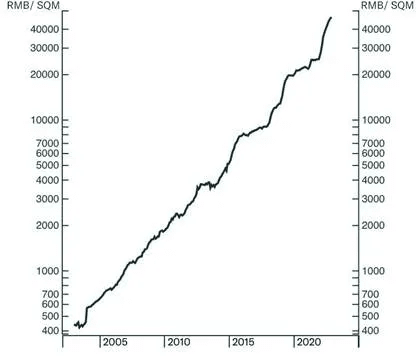
Over 19 years, land prices have increased 80 times, with a compound annual growth rate (CAGR) of 26%.
This housing price inflation has not undermined social stability because ordinary middle-class citizens can borrow money to buy at least one apartment. Therefore, everyone is involved. An extremely important secondary effect is that local governments primarily fund social services by selling land to developers, who then build apartments to sell to the 'plebes.' As housing prices rise, land prices and sales also increase, and tax revenues swell.
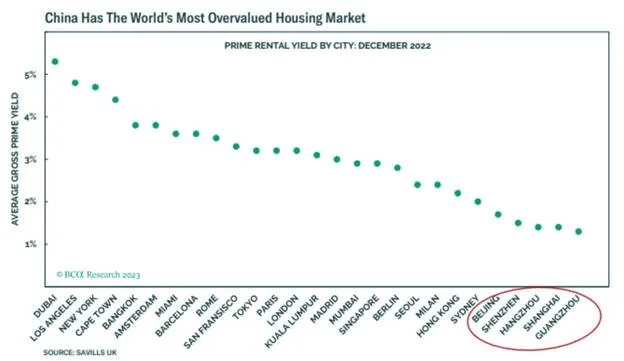
This case tells us that if the Trump administration really intends to fully implement economic fascism, the surplus credit growth must blow a bubble that allows ordinary people to profit while simultaneously funding the government.
The bubble that the Trump administration will blow will focus on the cryptocurrency sector.
Before I delve into how the crypto bubble fulfills various policy goals of the Trump administration, let me first explain why Bitcoin and cryptocurrencies will soar as the U.S. becomes a fascist economy.
I created a custom index called <.BANKUS U Index> on the Bloomberg terminal (white line). This is the sum of the reserves held by the Federal Reserve and other deposits and liabilities in the banking system, serving as a proxy for loan growth. Bitcoin is the gold line, both lines indexed to 100 as of January 2020. Credit growth doubled, and Bitcoin subsequently grew 15 times. The fiat price of Bitcoin has a highly leveraged effect on credit growth.
At this point, neither retail nor institutional investors can deny that if you believe more fiat currency will be created in the future, Bitcoin is the best investment choice.
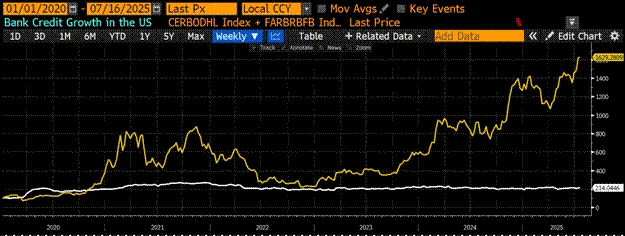
Trump and Bessent have also been 'orange-pilled' (influenced by Bitcoin thought). From their perspective, the best part of Bitcoin and the entire cryptocurrency space is that, compared to the wealthy white baby boomer generation, traditionally non-stock-holding demographics (young people, the poor, and non-whites) have a higher proportion of cryptocurrency ownership. Therefore, if cryptocurrencies thrive, they will create a broader, more diverse group of people who feel satisfied with the ruling party's economic platform.
Additionally, to encourage all types of savings to invest in cryptocurrencies, according to a recent executive order, 401(k) retirement plans are now explicitly allowed to invest in crypto assets. These plans hold about $8.7 trillion in assets. Boom Shak-A-Laka!
The fatal blow is President Trump's proposal to eliminate capital gains tax on cryptocurrencies. Trump is offering a war-driven frenzy of credit growth, regulatory permissions allowing retirement funds to invest cash into cryptocurrencies, and — TMD, no taxes! Hooray!
All this is fine, but there is one issue. The government must issue more and more debt to fund procurement guarantees provided to private companies by the Department of Defense and other agencies. Who will buy this debt? Cryptocurrency wins again.
Once capital enters the crypto capital market, it usually does not leave. If an investor wants to watch from the sidelines, they can hold stablecoins pegged to the dollar, like USDT.
USDT invests in the safest traditional finance (TradFi) yield-generating instruments: Treasury bills, to earn returns on its custodial assets. Treasury bills have a maturity of less than one year, so interest rate risk is close to zero, and they are liquid like cash. The U.S. government can print dollars infinitely for free, so nominal default will never occur. Treasury bill yields currently range from 4.25% to 4.50% depending on maturity. Therefore, the higher the total market cap of cryptocurrencies, the more funds accumulated by stablecoin issuers. Ultimately, most of these custodial assets will be invested in Treasury bills.
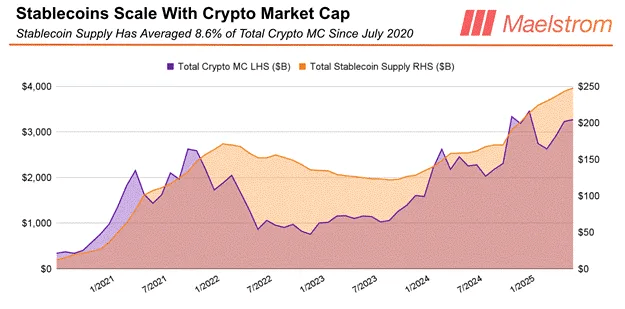
On average, for every $1 increase in the total market cap of cryptocurrencies, $0.09 flows into stablecoins. Let’s assume that Trump diligently pushes the total market cap of cryptocurrencies to $100 trillion by the time he leaves office in 2028. This would represent an approximately 25-fold increase from current levels.
If you think this is impossible, it shows you haven't been in the cryptocurrency space long enough. This will create about $9 trillion in purchasing power for Treasury bills, achieved by stablecoin issuers through global capital inflows.
Historically, when the Federal Reserve and the Treasury needed to fund America's WWII adventures, they also resorted to issuing far more Treasury bills than bonds.
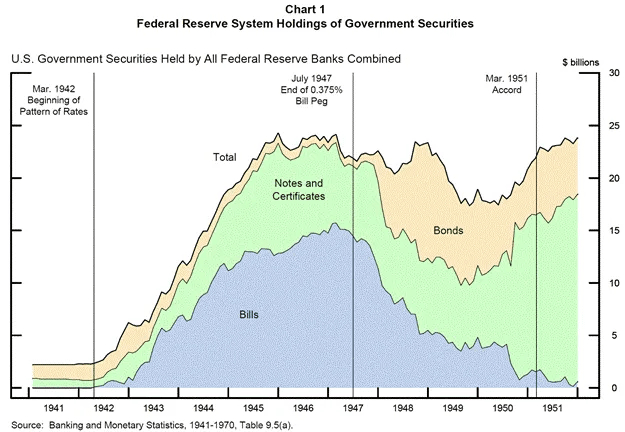
Now, Trump and Bessent have 'drawn circles' (solved the problem):
They replicated the Chinese model, creating a fascist economic system in the U.S. to produce goods.
The inflationary impulse of financial assets triggered by credit growth is directed towards cryptocurrencies, which soar, making the public feel wealthier due to their astounding returns. They will vote for Republicans in 2026 and 2028... unless they have a teenage daughter... or maybe the public always votes with their wallets.
The continuously rising crypto market brings a massive influx of funds into stablecoins pegged to the dollar. These issuers invest their custodial assets in newly issued Treasury bills, which fund the ever-expanding federal deficit.
The bass drum is beating. Credit is being pumped. Why haven't you fully invested in cryptocurrencies yet? Don’t fear tariffs, don’t fear war, and don’t fear randomly occurring social issues.
Trading strategy
It's simple: Maelstrom is fully invested. Because we are degens, the altcoin space offers incredible opportunities to outperform Bitcoin, this crypto reserve asset.
The upcoming Ethereum bull market will completely ignite the market.
Since Solana surged from $7 to $280 from the ruins of FTX, Ethereum has been the least favored among large cryptocurrencies. But now it's different; the Western institutional investor group, led by cheerleader Tom Lee, is very fond of Ethereum.
Buy first, ask questions later. Or don’t buy, and then like a grumpy guy, sip on a light beer that tastes like urine in the corner of the club while a group of people at the next table, whom you think are not as smart as you, spend big bucks on champagne.
This is not financial advice, so decide for yourself. Maelstrom is doing everything about Ethereum, everything about DeFi, and everything driven by ERC-20 altcoin plays.
My year-end goal:
Bitcoin = $250,000
Ethereum = $10,000
Yacht freedom, TMD!
#以太坊突破3700 #币安HODLer空投C #Strategy增持比特币
$ETH $BTC

